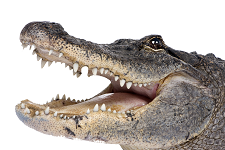Status, Fun Facts and Alligator Safety:
Once on the verge of extinction, the American alligator has made a remarkable recovery. Due to strict conservation measures and extensive research, it is no longer endangered except in scattered areas of its range. However, the American alligator is listed as threatened on the U.S. Endangered Species List because it is very similar in appearance to the American crocodile, which is endangered, and hunters are likely to confuse the two species. Hunting is allowed in some states, but it is heavily controlled. The greatest threat is currently destruction of habitat; this includes water management systems and increased levels of mercury and dioxins in the water.
Because alligators will feed on almost anything, they pose a mild threat to humans. In Florida, where there is the greatest alligator population, there were five deaths to alligator attacks from 1973 to 1990. Dogs and other pets are also sometimes killed.
Fun Facts:
The alligator became the official state reptile of Florida in 1987.
The alligator family includes the American and Chinese alligators and all caimans. Spanish sailors visiting the New World thought the unfamiliar alligator was a huge lizard. In Spanish, el lagarto means the lizard. English sailors took the name as allagarter and in time it has become alligator.
Alligators are hunted mostly for their skins, but also they are hunted for meat. Today, there is a multi-million dollar industry in which alligators are raised in captivity for the production of meat and skin. Also, alligators are a tourist attraction, especially in Florida, where visitors enjoy feeding them.
Alligator Safety
- STAY at least 60 feet (4 car lengths) away from alligators.
- DO NOT feed alligators.
- DO NOT crab or fish near alligators.
- DO NOT throw used bait or fish parts back into water after fishing or crabbing.
- DO NOT throw objects at alligators or harass them in any way.
- KEEP children and pets away from the edges of lakes and ponds.
- KEEP OUT of secluded pond areas where alligators may nest. Females are very protective of their nest and young.

